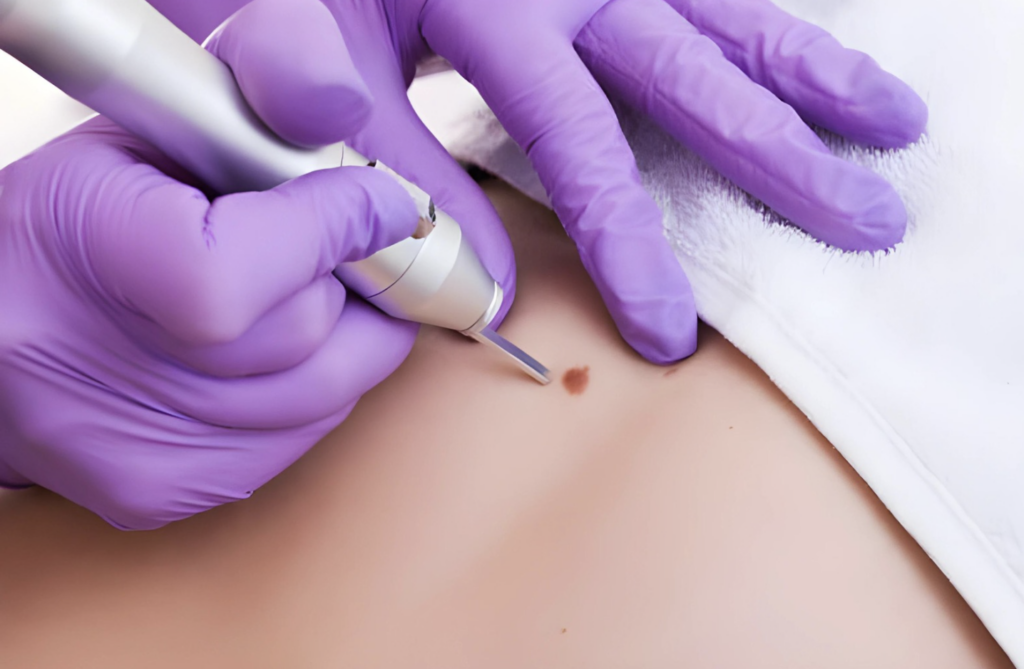Alternative Treatments, Health Conditions
Latest Methods and Procedures for Treating Skin Cancer
Skin cancer is a persistent danger in oncology, defined as the abnormal proliferation of malignant cells inside skin tissues.
As one of the most common cancers in the world, its incidence is increasing due to a complex interplay of environmental exposures, genetic predispositions, and other variables. In the pursuit for effective management, the cardinal concepts of early detection and fast intervention are paramount.
Navigating the landscape of skin cancer treatment requires a thorough grasp of a variety of factors, including tumor subtype, disease stage, patient demographics, and anatomical site. Therapeutic techniques, ranging from traditional surgical treatments to novel modalities such as targeted therapy and immunotherapy, are rigorously customized to enhance outcomes while maintaining quality of life.
In this article, we will explore the varied landscape of skin cancer, including its origin, treatment approaches, and prevention efforts. By raising awareness and advocating for preventative measures, we hope to create a future in which the scourge of skin cancer is reduced and the promise of optimal health and well-being prevails.

Diagnosing Skin Cancer
Skin cancer is detected using a variety of techniques, including a visual inspection of the skin, a skin biopsy, and staging. A dermatologist is a professional who can detect and cure skin cancer.
Types of Skin Biopsy
A skin biopsy is a technique that involves removing a sample of skin tissue and examining it under a microscope to determine whether it is malignant. There are three primary types of skin biopsy:
- Shave biopsy involves shaving a tiny layer of skin with a scalpel or razor blade.
- Punch biopsy: A small, circular piece of skin is extracted with a tool that resembles a tiny cookie cutter.
- An excisional biopsy involves removing the entire tumor or questionable area using a scalpel.
The size and location of the suspicious spot determine the sort of biopsy that is performed.
Staging and Its Importance
Staging is the process of identifying the size of a cancer and whether it has spread to other places of the body. This information is critical in identifying the optimal course of treatment.
Staging is frequently performed following a skin biopsy and may include imaging tests like X-rays, CT scans, and MRI scans. The pathologist will study the biopsy sample and determine the stage of the cancer based on its size and depth, as well as if it has spread to neighboring lymph nodes or other organs.
Finally, identifying skin cancer requires a visual inspection of the skin, a skin biopsy, and staging. It is critical to see a dermatologist for an accurate diagnosis and treatment.

Treatment Options Overview
Skin cancer treatment methods differ according to the type, size, and location of the malignancy. Surgical techniques, non-surgical therapy, developing medicines, and clinical trials are among the most prevalent alternatives for treating skin cancer.
Surgical Procedures
These are one of the most prevalent methods for treating skin cancer. These procedures include removing malignant tissue from the skin. Depending on the size and location of the cancer, the surgeon may employ one of the following techniques:
- Excision is the removal of malignant tissue along with a healthy skin margin.
- Mohs surgery involves removing the diseased tissue layer by layer and inspecting each layer under a microscope until no cancer cells remain.
- Curettage and electrodesiccation include scraping the diseased tissue and employing an electric current to eliminate any leftover cancer cells.
- Cryotherapy involves freezing malignant tissue with liquid nitrogen.
Non-Surgical Therapies
Nonsurgical therapy are another alternative for treating skin cancer. These therapies can be used alone or in conjunction with surgical procedures. Some of the most prevalent non-surgical interventions are:
- Radiation therapy involves employing high-energy radiation to eliminate cancer cells.
- Chemotherapy is the use of chemicals to kill cancer cells.
- Immunotherapy is the use of medications to assist the immune system fight cancer cells.
- Photodynamic therapy uses a specific light and a photosensitizing chemical to kill cancer cells.
Emerging Treatments and Clinical Trials
Some skin cancer patients may also be able to benefit from new medicines or clinical trials. These treatments could include new medications, new combinations of current pharmaceuticals, or novel surgical procedures. Clinical trials are research investigations that determine if new medicines are safe and effective. Patients who enroll in clinical trials may have access to novel therapies before they become publicly available.

Surgical Treatment Techniques
Skin cancer is commonly treated with surgical treatments aimed at removing malignant cells from the skin. Several surgical treatment options exist, including Mohs surgery, excisional surgery, cryosurgery, and electrosurgery.
Mohs Surgery
Mohs surgery is a specialist surgical procedure for removing skin cancer. It is frequently used to treat basal cell carcinomas and squamous cell carcinomas, the two most common kinds of skin cancer. During Mohs surgery, a surgeon eliminates malignant tissue layer by layer until all cancer cells are removed. This approach permits the surgeon to remove all malignant tissue while leaving as much healthy tissue as feasible.
Excisional Surgery
Excisional surgery is a frequent surgical procedure for removing skin cancer. During this surgery, a scalpel is used to remove the malignant tissue as well as a margin of healthy tissue. The margin size is determined by the cancer’s size and kind. The tissue is subsequently sent to a laboratory for testing to ensure that all cancer cells have been eliminated.
Cryosurgery and Electrosurgery
Skin cancer can be removed using either cryosurgery or electrosurgery. Cryosurgery involves freezing malignant tissue using liquid nitrogen, which kills cancer cells. Electrosurgery uses an electric current to eradicate malignant tissue. Both procedures are commonly used to treat minor skin tumors and precancerous growths.
Finally, surgical therapy approaches are commonly utilized to treat skin cancer. Mohs surgery, excisional surgery, cryosurgery, and electrosurgery are all effective ways to remove malignant cells from the skin. The technique used is determined on the size, type, and location of the cancer on the body. To decide the best treatment option, consult with a knowledgeable healthcare expert.

Support and Management
Managing Side Effects
Skin cancer treatment can result in a variety of adverse effects, which must be managed carefully. Patients may develop skin irritation, tiredness, and other side effects. To ease these symptoms, your healthcare professional may offer drugs or topical therapies. It is critical to follow your healthcare provider’s recommendations and report any new or worsening symptoms.
Lifestyle Changes and Protection
Following treatment, patients should take efforts to protect their skin and avoid skin cancer recurrence. Wearing protective clothing, applying sunscreen, and avoiding prolonged sun exposure are all possible options. Patients should also lead a healthy lifestyle that includes a well-balanced diet and regular exercise to support their overall health and immunity.
Support Resources and Follow-up Care
A skin cancer diagnosis can be difficult, and individuals may require assistance and resources to manage the emotional and financial consequences of the disease. The Skin Cancer Foundation provides a list of organizations that can help with insurance, healthcare costs, transportation, coping support, and other concerns related to a skin cancer diagnosis. Patients should also see their doctor for frequent check-ups and screenings to watch for recurrences or new skin cancer developments.
To summarize, minimizing side effects, adopting lifestyle adjustments and taking precautions to preserve the skin, as well as employing support resources and follow-up treatment, are all key parts of skin cancer management. Patients should collaborate with their healthcare professional to create a thorough treatment plan that covers their specific needs and concerns.
Conclusion
To conclude, medical science and technology have improved the process involved in treating skin cancer. From innovative surgeries to targeted therapy and immunotherapy, this difficult disease’s treatment options are growing, giving sufferers hope.
After researching the latest ways of treating skin cancer, we’ve found that personalized care is key. Treatments customized to cancer subtype, stage, and patient demographics improve results and quality of life.
However, our quest continues. A holistic strategy that encompasses treatment, prevention, and early detection is essential. We can empower people to lower their risk of skin cancer and improve treatment outcomes by promoting sun-safe practices, awareness, and frequent skin screenings.
Let’s keep promoting skin cancer research, innovation, and collaboration. We can work together to eliminate this insidious disease and give everyone access to the latest therapy, giving hope and healing.
Trusted Health, Wellness, and Medical advice for your well-being



